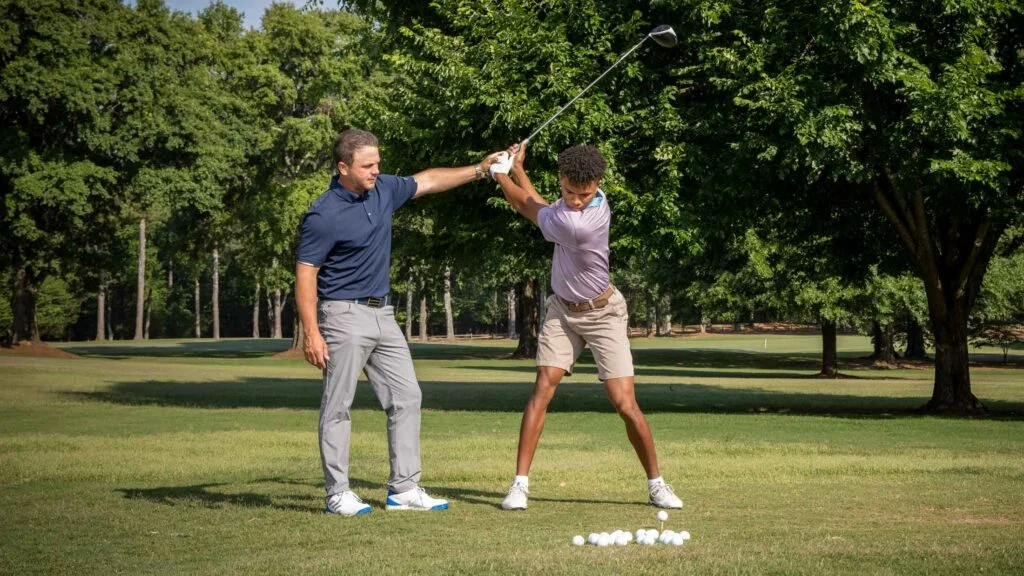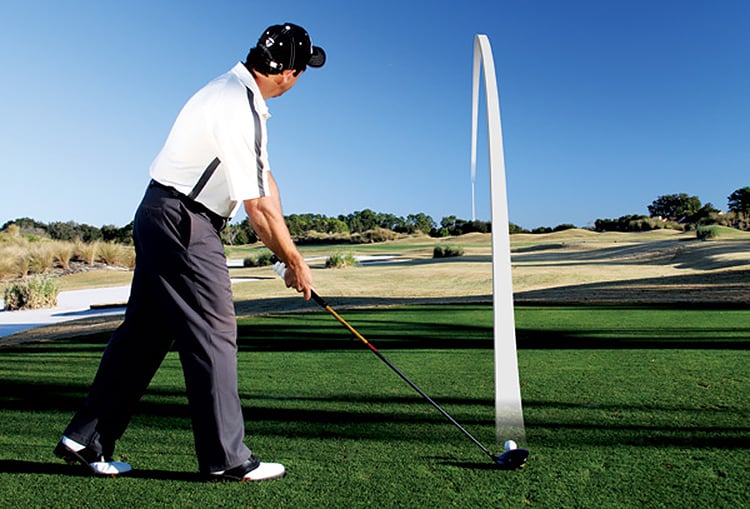How to golf
Key Takeaways:
1. Golf is a popular lifelong game due to its appeal and the rich history associated with it.
2. When getting started with golf, finding a friend or mentor can be helpful in learning the basics and getting comfortable with the game.
3. Improving your swing requires mastering techniques like hitting the ball in the air, understanding your clubs, and building confidence in club selection.
4. The short game is essential in golf, and mastering chip shots, managing risk, and tackling bunker shots can greatly improve your overall game.
5. Knowing the necessary equipment and learning golf rules and etiquette is important for a smooth and enjoyable golfing experience.
6. Distance control in putting is crucial, and mastering it can greatly improve your scores.
7. Taking lessons and utilizing resources can help you improve your skills and progress to playing on a golf course.
8. Ultimately, golf is a game to be enjoyed, and by following these tips and putting in practice, you can have a fulfilling and enjoyable experience.
Introduction: The Growing Popularity of Golf
Golf, a beloved sport that has stood the test of time, continues to capture the hearts of enthusiasts worldwide. From its enduring appeal as a lifelong game to the storied history filled with legendary players, this section will take you on a journey through the growing popularity and fascination surrounding golf.
The appeal and popularity of golf as a lifelong game
Golf has become a hugely popular pastime, appealing to people of all ages and backgrounds. This game offers a unique, long-lasting experience that captivates players. It has a rich history, famous players, and the chance to meet new people in a social setting.

Golf is both physically and mentally challenging. Precision, concentration, and strategic thinking are needed, making it stimulating. It gives people an opportunity to be active outdoors, whether walking the course or swinging the club.
Golf also has a great social atmosphere. It’s a great way to connect with friends or make new acquaintances. The relaxed environment encourages conversation and creates lasting friendships. Plus, etiquette and sportsmanship add to its appeal, as players learn to respect one another and appreciate fair play.
Golf is widely available for players of all levels. Beginners can practice at driving ranges and experts can compete at renowned courses. There’s always room for improvement in this sport, offering endless opportunities for growth and achievement.
The rich history and legendary players of golf
Golf is revered across the world for its rich and storied history. Legendary players have made their mark, like Old Tom Morris and Young Tom Morris, who shaped golf’s early developments. Jack Nicklaus and Tiger Woods are synonymous with greatness, having won many major championships. Annika Sorenstam and Lorena Ochoa are celebrated female golfers, inspiring aspiring women golfers.
These legendary players have had a huge impact on globalizing golf. They have captivated audiences worldwide and elevated the sport’s profile. Their contributions have shaped how we play and perceive golf, reminding us of remarkable achievements.
Getting Started
Whether you aim for a hole-in-one or just want to improve your swing, getting started with golf is an exciting journey. In this section, we’ll explore ways to kickstart your golfing adventure. From finding a friend or mentor to help guide you in the right direction, to mastering the basics of the game, we’ll provide you with valuable insights and tips to get you off to a great start on the golf course.
Finding a Friend or Mentor
Grasping the foundations of posture, grip, and stance is fundamental to becoming a pro at golf. Creating a pre-shot routine can lead to steadiness in your swing. Finding someone to help you and show you the ropes will hugely advance your learning.

To improve your swing, concentrate on hitting the ground during the stroke rather than just aiming for the ball in the air. Extending both arms into the ground can result in greater contact with the ball. Knowing your clubs and their distances is crucial. Utilizing apps or range finders can precisely trace these distances. Getting a friend or mentor to help you with club choice and give you guidance can be really helpful.
Apart from polishing your chipping shots with lots of practice with a pitching wedge, focusing on a basic putting motion is key to success in golf’s short game. Reducing danger by ranking putts, chips, and pitches while making clever decisions is essential. Having a friend or mentor to offer advice and feedback on your short game can rapidly boost your progress.
When it comes to gear and etiquette, you’ll need golf balls, a golf glove, tees, and a ball marker. Finding affordable equipment can be done through various tips and strategies. Having a friend or mentor who knows about equipment can aid you in making informed choices and finding the best bargains.
Acquiring golf rules and etiquette, including divot and ball mark repair and dealing with balls out of bounds, is necessary for a smooth experience on the course. A mentor can direct you through these rules and guarantee you are playing in accordance with proper golf etiquette.
Distance control in putting can be mastered by using backstroke length to control the distance covered. Regulating stroke size using feet as a guide also helps with effective distance control. Taking lessons from PGA coaches or using online resources suggested by a friend or mentor are beneficial for betterment. Recommended golf books and other learning materials suggested by a mentor can further sharpen your skills.
Shifting from driving ranges to playing on a course comes with its issues, but having a friend or mentor by your side can help you navigate these difficulties. Starting with par 3 courses is suggested for beginners.
Mastering the Basics: Where grip, stance, and posture are the only things you’ll be mastering, the rest of your swing is open to improvement. With the guidance and support of a friend or mentor, you can keep on finessing your skills and take your golf game to the next level.
Mastering the Basics
To ace the basics of golf, you need help from someone experienced. Get a friend or mentor to show you the ropes and give tips. Start at the driving range with borrowed clubs to focus on technique.

You must develop skills for hitting the ball in the air. Hit the ground during the swing. Extend your arms for better contact with the ball. Know each club’s distance capabilities. Use apps or range finders for tracking distances.
Having proper posture, grip, and stance is key. Make a pre-shot routine. Improve your swing technique. Understand equipment options. This way, beginners can progress towards becoming competent golfers. Improving your swing is a balance between finesse and frustration. But hey, you’ll have a cool backswing!
Improving Your Swing
To improve your swing in golf, it’s crucial to master three key aspects: hitting the ball in the air, knowing your clubs, and building confidence with club selection. Each sub-section offers valuable insights and techniques to help you enhance your golfing skills.
Whether you’re a beginner or looking to refine your game, understanding these fundamental elements will play a significant role in your success on the golf course. So, let’s dive into the world of improving your swing and take your golf game to new heights.
Hitting the Ball in the Air

Hitting the ball in the air is a must-have skill for golfers. You can do this by focusing on hitting the ground during your swing and extending both arms towards the ground. To master this skill, follow these three steps.
- Focus on the ground. When swinging, try striking down on the ground rather than lifting the ball. This will give you power.
- Extend your arms. As you approach the ball, extend both arms into the ground. This will help you control your swing and increase the loft of the shot.
- Practice different lies. To get used to different conditions, practice from uphill, downhill, and sidehill lies.
By practicing these steps, you can hit the ball in the air with better control and accuracy. Plus, it increases distance and helps carry over obstacles. Visualize a clean contact between your clubface and the back of the ball at impact to get the ball airborne quickly. Knowing your clubs is like having a cheat code for golf.
Knowing Your Clubs
Gaining an understanding of each club’s yardage capabilities is key for strategic decisions on the golf course. Apps or range finders provide valuable information to help with club selection and better shot accuracy.

When playing from the fairway, knowing your clubs well helps identify the club that fits your swing and delivers good results. Lofted fairway woods offer a great option to get consistent distance on long shots, with better launch angles, increased carry distances, and improved performance.
Apart from yardage, it’s important to learn the unique characteristics of each club: loft, forgiveness, workability, and feel. Practicing with each club individually will help become familiar with their tendencies. Varying grips, stances, and swing speeds will help you determine how they perform.
Knowing your clubs inside and out leads to confidence in your game. Club selections are improved, shots are more precise, and overall performance on the course is optimized. Selecting the right club makes a big difference in your game – just like a reliable wingman at a crowded bar!
Building Confidence with Club Selection
Golfers: Build Confidence in Club Selection!
Choose the Right Club: To hit consistent shots, select a reliable club from the fairway. Knowing how far each club goes is key for smart decisions.
Utilize Tech: Apps and range finders help players make informed choices. Accurate measurements mean the right club for desired yardages, leading to greater precision and confidence.
Lofted Fairway Woods: They offer consistent distance while providing enough loft for ball flight and control. Use these clubs to trust your equipment and boost performance.
Ready to take your game to the next level? Get started on building confidence in club selection today! Make informed decisions and maximize your potential on the course. Master this skill and enjoy golf even more!
Short Game Essentials
Mastering the short game is a fundamental aspect of golf. In this section, we will explore three key components: mastering chip shots, managing risk in the short game, and tackling bunker shots. These techniques and strategies will help you significantly improve your game and lower your scores. So let’s dive in and discover the essential skills needed for a successful short game on the golf course.
Mastering Chip Shots
Chip shots are an important skill in golf. To be successful, here are several things to remember:
- Practicing with a pitching wedge can help your chip shot technique. This club gives the right mix of loft and control, so you can hit accurate shots near the green.
- A basic putting motion is good for chip shots. Using this technique helps maintain control and accuracy when chipping the ball onto the green.
Managing risk with shorter shots is also key. Making use of putts, chips, and pitches depending on the situation helps avoid errors.
Bunker shots need a separate approach. Focus on hitting the sand first, not trying to lift the ball out of the sand. That will give you a higher chance of getting through bunkers.
These elements form the foundation for improving your golf game. You must also understand each scenario you could face on the course. Adjusting your strategy based on factors such as slope, wind, and distance to the pin is vital for successful chip shots.
Improving chip shots demands practice and refining technique. With dedication, you’ll be able to execute accurate and controlled chip shots consistently.
Managing Risk in the Short Game
When it comes to managing risk in the short game, golfers must prioritize shot selection and make wise decisions. This involves understanding the options, such as putts, chips, or pitches. Strategically assessing each shot and taking calculated risks can increase chances of success.
To manage risk, consider factors like lie conditions, pin placement, and overall course management. Analyze these elements carefully and make informed decisions to avoid mistakes that result in wasted strokes. Additionally, having basic bunker shot knowledge is key for managing risk around greenside bunkers. Aim for the sand instead of trying to lift the ball out.
Having a consistent putting stroke is essential for managing risk on the green. With practice, golfers can adjust backstroke length for desired putt distance. Also, regulate stroke size using feet as a guide. This can minimize three-putts and maintain control over speed and accuracy.
Tackling Bunker Shots
Bunker shots can be tough in golf. You have to get the ball out of a sand-filled hazard and onto the green. Precision and strategy are needed for this.
To do it well, try these steps:
- Assess the Situation: Work out how far you need to go and if there are any obstacles. This helps you choose the right club and shot.
- Proper Setup: Stand wide in the sand and open your clubface. This lets the sand help lift the ball.
- Execute with Control: Focus on hitting two inches behind the ball. Swing aggressively but stay in control. Follow through after you hit.
Practice is key. Get the right equipment and etiquette to improve your game.
Equipment and Etiquette
When it comes to golf, having the right equipment can make all the difference in your game. In this section, we will explore the necessary equipment you need to excel on the course. But it’s not just about the gear – understanding and adhering to golf rules and etiquette is equally important. We’ll dive into the importance of learning golf rules and etiquette and how it can enhance your overall golfing experience. So, let’s tee off into the world of golf equipment and etiquette.
Necessary Equipment
Golfers need certain gear to play the game well. This includes golf balls, a golf glove, tees, and a ball marker. Golf balls are vital for striking shots while a glove offers grip and control. Tees are used for lifting the ball when teeing off, and a marker for noting the ball’s spot on the green.
Rules and etiquette are essential too. This includes understanding how to fix divots and ball marks on the course as well as handling balls that go out of bounds.
Pro Tip: To get cost-effective gear, consider buying pre-owned clubs or watch out for sales at local sports stores. Knowing golf rules and etiquette is essential for all golfers. As getting hit by a wayward golf ball can cost friends and gain you embarrassing enemies.
Learning Golf Rules and Etiquette
Golf rules and etiquette must be understood by any player who wants to fully enjoy and partake in the game. Knowing these basics of the sport ensures a fair and polite experience on the course. These rules include repairing divots, fixing ball marks, and dealing with balls that are out of bounds. Obeying these guidelines encourages good sportsmanship and keeps the game pure.
When learning golf, one should get to know standard practices on the course. This includes understanding how to repair divots caused by shots on the fairway or elsewhere. Players should also recognize how to appropriately fix ball marks on the green for a smooth surface when putting.
It is also important to know how to golf – a comprehensive guide for beginners that covers everything from grip to swing to putting techniques. Additionally, players should know how to handle balls that go out of bounds or into hazards, with certain steps taken for penalty shots or dropping a ball in designated places.
Players should also pay attention to pace of play and proper behavior while on the course. It is customary to let faster groups play through if waiting behind, allowing everyone to have a fun round without feeling rushed. Moreover, players must not talk during another player’s swing and must be respectful of others by not distracting them when they are getting ready or hitting their shot.
Learning golf rules and etiquette allows players to have a better experience on the course, while also displaying respect for other golfers and keeping the game true. These principles give shape and fairness in both competitive games and casual outings, permitting all involved to truly enjoy this long-lasting sport.
Distance Control and Putting
Mastering the delicate art of distance control in putting is crucial for success on the golf course. In this section, we will explore effective techniques and strategies to improve your ability to judge and control the distance of your putts.
From understanding the intricacies of green speed to honing your touch and feel, we will uncover the key factors that contribute to mastering distance control in putting. Get ready to fine-tune your putting game and watch your scores plummet!
Mastering Distance Control in Putting
In golf, mastering distance control in putting is essential. Pay attention to backstroke length. Control how far the putter goes back to better regulate the ball’s distance. Use feet as a reference point to calculate how much force to apply.

Keep a steady rhythm and tempo when putting. Visualize a virtual clock face on the green. Six o’clock is closest, twelve o’clock is furthest.
Practice on different types of greens. Experiment with grip styles like overlapping or reverse overlap. Improves overall feel and accuracy.
Patience and persistence are key. Practice and focus on techniques for improved success. Read the green and understand slope and break. Maintain a consistent tempo for distance control. Practice different lengths of putts.
Legendary golfers Bobby Jones and Ben Crenshaw had superb touch on the greens. Their success was due to hours of practice and attention to detail. Golfers at all levels recognize the importance of mastering distance control in putting for success on the course.
Additional Tips for Improvement
Looking to improve your golf game? Dive into additional tips to take your skills to the next level. Discover the advantages of taking lessons and utilizing available resources. Then, find out how to progress from practice sessions to confidently taking on the golf course. Get ready for a game-changing transformation on the greens!
Taking Lessons and Utilizing Resources
Golfers must take lessons and use resources to sharpen their skills. Seeking help from PGA coaches and online sources can bring valuable insights and techniques.
Coaches: It’s key to get lessons from qualified PGA instructors to make progress in golf. They have plenty of knowledge and experience to detect and fix mistakes in technique. Coaches can help players develop form, improve swing mechanics, and improve overall performance.
Online Resources: As well as traditional lessons, golfers can benefit from many online resources. Websites, videos, and apps offer content for different skill levels. Golfers can find tips on grip techniques, shot selection strategies, and mental prep.
Books: Books are a great resource for avid golfers. There are many by experts about technique, strategy, course management, mental approach, and more. By studying these books, players can gain a better understanding of the game and refine their skills.
Other Materials: Besides books, there are other learning materials that can boost golf instruction. DVDs with professional golfers’ tutorials, or training aids like alignment sticks or putting mirrors, offer guidance and feedback. Incorporating these materials into practice helps reinforce technique and muscle memory.
Practice: Taking lessons and utilizing resources should go hand in hand with regular practice sessions. This includes drills from instructional materials or strategies during rounds. With continuous learning and practice, golfers can steadily improve.
Using this approach to lessons and resources, individuals can effectively enhance their skills, gain a better understanding of the game, and enjoy playing golf to its fullest.
Progressing to the Golf Course
Master the basics and upgrade your swing. Now it’s time to move onto the golf course! Playing on a course is different than hitting shots on the range. Start with par 3 courses for beginners. These usually range from 100-200 yards, making it more manageable. Focus on your short game and gain confidence from various distances.
When playing on a course, obey golf etiquette. Fix divots and ball marks, handle balls out of bounds, and keep proper pace of play. Respect other players – show them you are aware of their presence.
As you move from the range to the course, stay positive and persevere through challenges. Golf can be tough but also very rewarding. Appreciate the beauty of the course and show your skills. With practice, you’ll keep improving and have a lot of fun!
You can accelerate your progress with lessons from PGA coaches or online resources. Also, golf books from professionals can deepen your understanding. Invest time in learning these resources for a strong foundation of improvement.
Conclusion: Enjoying the Game of Golf
Golf is a joyful experience for those who play it! Developing a powerful swing and refining one’s putting technique can make the game even more rewarding. Plus, you get to wander outdoors, admiring the beautiful view and breathing in the fresh air of the golf course.
As players submerge themselves in the game, they realise it involves more than physical skills – it also requires mental strategy. By understanding and using tactics, players can increase their pleasure. Additionally, golf is a game that can be enjoyed by all ages, which makes for an inviting atmosphere. The companionship and competition add to the enjoyment of golf.
An intriguing component of golf is the manners and sportsmanship required from players. Golf encourages respect for each other, the course, and the game’s customs. This accentuates the general experience, making a sense of camaraderie and admiration between golfers. Also, the self-control expected in golf allows players to take charge of their actions, further enhancing their satisfaction.
Golf has a unique story. From Scotland to becoming a worldwide sport, golf has lasted. Many iconic players have left their mark on golf, inspiring next generations. As golf keeps evolving and adapting, modern technologies and ideas are continuously affecting the way it is played and appreciated.
Golf is more than a game; it is an exceptional experience that blends physical talent, mental strategy, friendship, etiquette, and compelling history. By appreciating all components of the game, players can truly enjoy the sport and everything it brings.
From the challenge of honing your skills, the joy of being in the great outdoors, to the gratification of respecting the traditions of golf, this game offers a fulfilling and fun experience to fans, of any age.
Some Facts About How to Golf:
- ✅ Beginner golfers should focus on mastering the basic fundamentals of posture, grip, and stance. (Source: Golf.com)
- ✅ Knowing the distance each club can hit is important for consistency on the course. (Source: Golf.com)
- ✅ Being able to hit a basic chip shot is important for when golfers are close to the green. (Source: Golf.com)
- ✅ Beginner golfers should be prepared with the necessary equipment, including golf balls, a golf glove, tees, and a ball marker. (Source: Golf.com)
- ✅ Taking lessons with a PGA coach is a great way to start learning golf. (Source: Shot Scope)
FAQs about How To Golf
What are the basic rules of golf?
The basic rules of golf include playing the course in the order of the holes, keeping score for each hole, and following etiquette such as teeing off behind markers and yelling “Fore!” to warn others.
Where can I learn how to play golf?
You can learn how to play golf by taking lessons with a PGA professional or joining group beginner lessons. You can also practice at driving ranges, 9-hole pitch and putt courses, or par 3 courses before transitioning to full-length courses.
Can I hire out golf equipment if I don’t have my own?
Yes, many golf courses and driving ranges offer equipment rentals for those who don’t have their own clubs.
Is golf a life-long game?
Yes, golf is a game that can be enjoyed and played throughout your life. It teaches important life skills and can be a rewarding and challenging hobby.
How can I improve my golf swing?
You can improve your golf swing by taking lessons with a trained golf instructor, practicing with a range routine that focuses on different clubs and shots, and using technology such as swing analysis tools like the V1 Swing Suite or Boditrak Pressure Mapping.
What are some recommended golf courses to play?
Some recommended golf courses to play are Simi Hills Golf Course, Transcends Generations, and Executive Course. These courses offer a variety of challenges and are suitable for beginners and experienced golfers alike.




